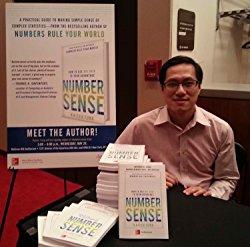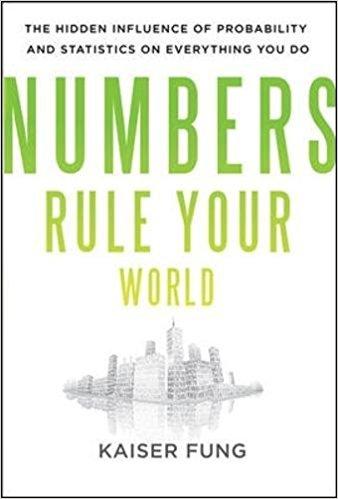Numbers Rule Your World Summary
4 min read ⌚
 The Hidden Influence of Probability and Statistics on Everything You Do
The Hidden Influence of Probability and Statistics on Everything You Do
An invisible force guides our lives.
No, it is not God, it is statistics.
But if numbers play such a vital role in our lives, why don’t we pay them more attention?
In the following summary, we give you an overview of the five principles of statistical thinking, which can make significant changes in your life.
Who Should Read “Numbers Rule Your World”? and Why?
Kaiser Fung has created “Numbers Rule Your World” as a guideline that you can use to understand statistical information and improve your world. You can use this kind of reasoning in various contexts.
We recommend this book to readers who want to reap the benefits of statistical reasoning, as well as those interested in statistics overall.
About Kaiser Fung
 Kaiser Fung is an author and statistician, holding degrees from Harvard Business School, Princeton University and the University of Cambridge.
Kaiser Fung is an author and statistician, holding degrees from Harvard Business School, Princeton University and the University of Cambridge.
“Numbers Rule Your World Summary”
Have you ever been in a bank, waiting in like thinking that if they had just one more person working, all the lines would be shorter?
We get that it may seem that adding workers would lead to shorter queues, but surprisingly it is not the case.
Wait, what?
Yes! According to studies, it is the changing pattern of when customers arrive and not the average number of customers arriving that makes the queues long.
What does this mean?
Well, if businesses would accurately predict demand, they could create the capacity to accommodate it.
Unfortunately, it is easier said than done.
Let’s take another example.
At amusement parks, people also wait in lines. Statisticians argue that even if workers accurately predicted the number of visitors, a line would still form since customers come at irregular intervals during the day. And, of course, the rides’ capacities are fixed.
What we wanted to explain with this example is that planning for capacity is possible when it comes to average rises in demand, but not when it comes to fluctuating demand.
Statistics can be used everywhere!
It can be used for determining a person’s creditworthiness, for determining the sources of diseases, to deciding whether one is lying, for insurance, etc.
What is important to note is that statistic reasoning uses the differences between groups of people. It does not matter what kind of a difference is in play, in any case, differences are fundamental.
For example, statistics take into consideration these differences during designing exams. For standardized exams to be fair, statisticians must make sure that they omit the questions which give preference to one group over another.
It is logical: a question would be unfair if the phrasing is more apparent to the African-American community than for the white exam-takers.
However, how do they determine which questions are fair and which are not?
They do so by making a statistical analysis, based on the performance of black and white students on every question. However, the racial background is not the only thing that is important when conducting such an analysis.
Statisticians have to take into consideration the educational background and the success of the test-takers. In other words, they must not compare between a group of high-performers with a group of low-performers.
What this means is that the comparison does not happen between just white and African-American students, but between both low-performing and high-performing students coming from each demographic.
It seems that nowadays it is difficult to keep the truth hidden. Just think of all methods developed to uncover the truth: from drug tests to lie detectors.
However, you have to keep in mind that there is not a 100 percent chance for anything. In other words, exceptions exist, and there will always be someone who gets away with it, whatever it is.
Key Lessons from “Numbers Rule Your World”
1. Lie Detector Tests
2. Finding the Cause of Diseases
3. Questioning Obvious Patterns
Lie Detector Tests
Polygraphs are prone to some unavoidable trade-offs.
They work by analyzing the subject’s blood pressure and breathing while they answer a series of questions. The collected medical statistics show the changes in the person’s psychological state, and thus points to false information.
Detectives want to avoid false negatives, or guilty people going free. However, what this means is that many innocent people get accused because of false positives.
Finding the Cause of Diseases
Epidemiologists find the cause of a disease by using statistics to come up with causal relationships that can point to the origin of the disease’s outbreak.
For instance, let’s imagine that several patients show signs and test positive for E. coli. Just by studying these few cases, epidemiologists can predict the disease’s source and hence protect others from it.
How do they do that?
By questioning patients about what they eat, finding foods in common and using statistics to reveal the source.
Questioning Obvious Patterns
In 1999 an EgyptAir jetliner crashed into the Atlantic Ocean, leaving no survivors.
However, before this tragedy happened, three other jets followed the same scenario around the same location, in the past four years.
As a result, many people avoided flying in the area. The logic they followed was that the crash of four planes in four years is too much of a big coincidence.
Statisticians, on the other hand, questioned this obvious pattern and looked at the bigger picture. Thet found four crashed planes and millions of others safely traveling in the same airspace.
As a result, they realized that it is all up to odds: one in ten million planes crash.
Like this summary? We’d Like to invite you to download our free 12 min app, for more amazing summaries and audiobooks.
“Numbers Rule Your World” Quotes
The safest part of your journey is over. Now drive home safely. Share on X The modern obsession with measurement has made us none the wiser. Share on X Statisticians do not care much for the popular concept of the statistical average; instead, they fixate on any deviation from the average. Share on X Statisticians worry about how large these variations are, how frequently they occur, and why they exist. Share on X We should worry more about the variability of waiting time than about its average. Share on XOur Critical Review
An interesting and fun read, especially if numbers are your thing. However, people that expect many facts and statistic strategies might get disappointed, since there is a significant amount of storytelling present in the book.
Emir is the Head of Marketing at 12min. In his spare time, he loves to meditate and play soccer.


 The Hidden Influence of Probability and Statistics on Everything You Do
The Hidden Influence of Probability and Statistics on Everything You Do




